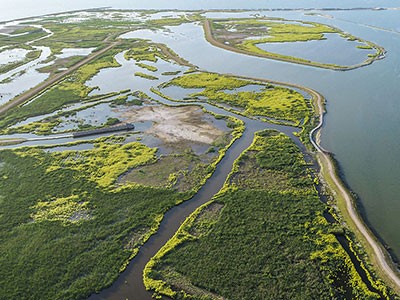Zoologist Yolarnie Amepou heard whispers about the fish frenzy when she made her first trip to the Kikori River Delta in the remote reaches of southern Papua New Guinea.
It was January 2012, and Amepou was travelling down the delta by dinghy, from village to village, as part of a research project on the vulnerable pig-nosed turtle (Carettochelys insculpta). Amepou heard talk of outsiders appearing across the region offering staggering amounts of cash for swim bladders — an organ cut from some of the delta’s large fish species that helps them to control buoyancy. Consumers in Asia, particularly southern China, know this commodity as fish maw and covet it as a culinary delicacy, a traditional medicine and a symbol of prosperity.
The global maw trade has been growing rapidly over the past 25 years1, and market prices now far exceed those of similar dried seafood luxuries such as shark fin and sea cucumber, which are also prized in China. In some low- and middle-income countries where demand for maw is very high, it is sometimes called the cocaine of the seas because it is so lucrative and attracts organized crime interests.
Papua New Guinea has become the source of some of the most sought-after maw. In the years since Amepou’s first visit, she’s watched the fish-maw industry in the Kikori delta explode, “like a fisheries gold rush”. Fishers replaced their paddle canoes, lines and hooks with outboard-powered dinghies and commercial nets. The price being offered to delta fishers for dried maw from one prized species — the scaly croaker (Nibea squamosa) — has been recorded at up to US$15,615 per kilogram — potentially the highest price offered to fishers for maw in the world, according to a study by Amepou and her colleagues published earlier this year2.
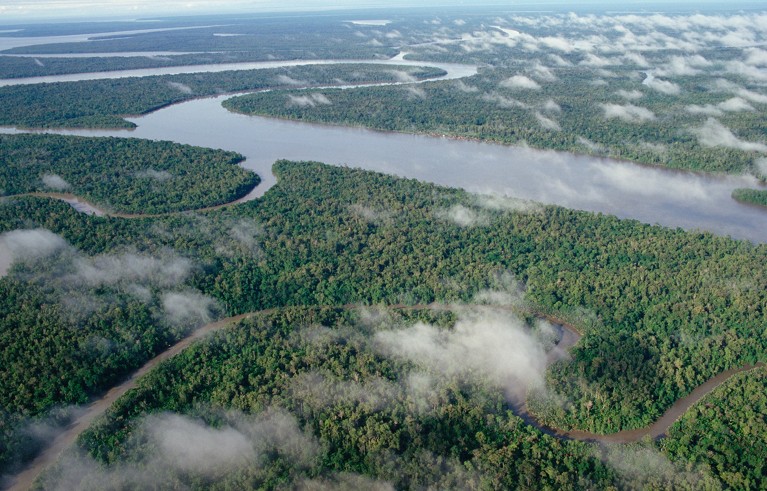
The Kikori river delta is the source of some of the most highly prized maw in the world.Credit: Minden Pictures/Alamy
Revenue from the maw industry is a lifesaver for many delta communities, with some people using it to move away from the coast to escape rapidly rising seas. “Fish maw has alleviated some quite severe poverty issues,” says Michael Grant, a marine biologist at James Cook University in Townsville, Australia, who researches Papua New Guinea’s sharks and rays in the Kikori delta, one of their last strongholds. Its waterways and mangroves are recognized as a sanctuary of biodiversity and have been nominated for inclusion as a World Heritage Site on the list maintained by the United Nations cultural organization UNESCO.
Grant and others fear that the sharp increase in fishing pressure in the Kikori delta and the use of gillnets — which indiscriminately capture many types of fish, dolphin and turtle — could recreate problems that have plagued Mexico, China and parts of Africa, where the maw trade has fished some species into near oblivion. That threat risks damaging the delta’s ecosystems and leaving people worse off, says Grant.
The information coming out of Papua New Guinea “is worrying, because it does seem to fit what we’ve seen in other places wherelittle-known species are targeted for the value of their maw”, says Yvonne Sadovy, a Hong Kong fisheries specialist now based in the United Kingdom. Along with Grant and other members of a species-survival commission that is part of the International Union for Conservation of Nature (IUCN), she contributed to a paper sounding the alarm on the increasing maw trade that was submitted by the United States to a meeting of the Convention on International Trade in Endangered Species of Wild Fauna and Flora (CITES) in July.
“There are very few controls and there is very little knowledge, I think, by the government fishery departments about the value, importance and potential threats of this,” says Sadovy. The consequence is “a sort of cowboy frontier”, whereby high prices push fishers to target species that “we hardly know anything about in terms of the science”.
Turtle troubles
Amepou wasn’t too concerned when she first heard about the fish-maw trade. In her early years in the Kikori region, she was focused on how hunting and habitat changes were threatening the pig-nosed turtle. The work took her to far-flung villages to monitor nesting sites, survey the consumption of turtle meat and eggs, and build community awareness about the vulnerability of the creatures known as piku.
By 2019 she was known locally as mama piku, and was the director of a small conservation organization, the Piku Biodiversity Network, which she still runs. Amid the other changes in the region, the fish-maw trade had become yet another threat to the turtle’s survival because the animals were getting tangled in commercial gillnets that seafood companies were supplying to local fishers.
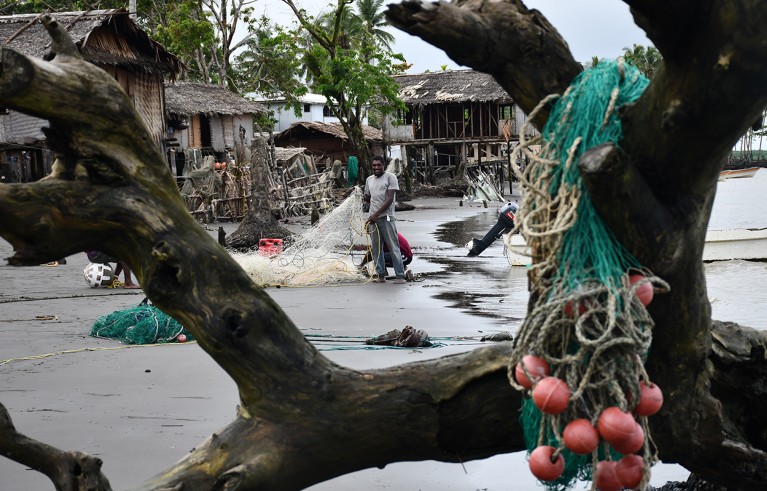
Rising sea levels have damaged the remote village of Veraibari.Credit: Jo Chandler
The remoteness and logistical difficulties of working in the Kikori delta — a region with little electrical power, few roads, fragmentary communications and 4–8 metres of rainfall a year — mean that Amepou, Grant and their collaborators are among just a handful of researchers who are active in the area. With support from the Secretariat of the Pacific Regional Environment Programme (SPREP), a multinational organization focused on the region’s natural resources, they collected data on targeted maw species, as well as by-catch. A survey of landings in gillnets reported by fishers from five delta communities over six months to April 2022 found that the hunt for fish maw pulls up huge numbers of non-target fish and mammals3.
Elasmobranchs — a subclass of fish that includes sharks and rays — accounted for almost half the catch, whereas target species made up just 22%. Among the other casualties were several species listed as endangered or critically endangered on the IUCN Red List, including three species of hammerhead shark, the giant guitarfish (Glaucostegus typus) and the bottlenose wedgefish (Rhynchobatus australiae), alongside various vulnerable river sharks and critically endangered Indo-Pacific sawfishes (Pristidae)2.
Other reports, some unpublished, document declines in two endemic dolphin species that have small local populations and are listed as vulnerable on the IUCN Red List. On one occasion, fishers reported that ten dolphins drowned in a single net, says Amepou. “You’re looking at the very real possibility of a local extinction if nothing is done about the gillnets in the water,” she says.
But discussions with local people about curtailing fishing practices for conservation purposes are acutely sensitive given the money flowing into the economically disadvantaged region. “While local fishers acknowledge sustainability concerns, the overarching feeling is everyone is pretty happy for now,” says Grant. “Whether fish-maw money is going back into community and development remains to be seen, and this is our next research focus.”
In 2022, the researchers submitted a report to SPREP on the Kikori maw fishery, urging the development of a management plan3. Sources have told Nature that work on a plan has commenced, but Papua New Guinea’s authorities did not respond to questions from Nature on its progress. In 2021, the National Fisheries Authority stopped issuing new fish-maw licences in Gulf Province, where the Kikori delta is located, and in the neighbouring Western Province, owing to increasing illegal, unregulated and unreported activities in the two fisheries.
Villages at risk
After storm surges destroyed many houses in the delta village of Veraibari in 2020, the people formed a relocation committee. They plan to use the windfall maw money to build around 200 homes, a school, a market and churches a short distance inland from the beach where they currently live. The committee estimates that this plan will cost 1,689,000 Papua New Guinean kina (US$431,000). In recent years, waves have damaged and closed the schoolhouse, knocked down freshwater tanks and submerged burial grounds. Abandoned homes decay on their stilts in the shallows alongside the stumps of drowned palm trees.
“The land is disappearing, the high land is going down, and then it is very easy for water to enter into the village,” says community and church leader Ara Kouwo. When the big tides come, his family wades into the sea to push away debris that might tip their home off its legs.
Kouwo is also the local agent buying maw for one of the six seafood companies, all Asian-led, with licences in Gulf Province. He conducts business at his family table, weighing and trading fish maw, offering 5,000 to 6,000 kina per 100 grams for the finest specimens. He kicked off the relocation fund with his own earnings, urging his neighbours and relatives to provide cash or other contributions. They are lobbying for more government support, but have so far received only sandbags to build a seawall, which soon failed, and some iron roofing, nails and a sawmill to help with the relocation. Money earned from fishing is the only way to save the village, he says, although he recognizes the risks.
If there was any other help coming to pay for the new village, “then we would stop these fishing activities”, he says. “We are in fear,” he adds. “When we kill all mothers of the fish, we are in trouble.”
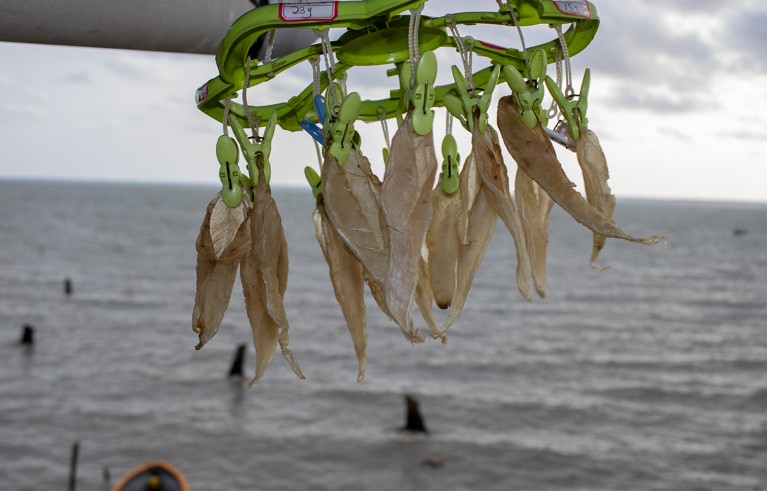
Maw drying outside in a delta community.Credit: Yolarnie Amepou/Piku Biodiversity Network
Environmental lawyer Watna Mori at Blue Ocean Law, a firm based in Hagåtña, Guam, is part of a team assisting the people of Veraibari to argue a case for funding from the UN for loss and damages due to climate change. She says that the tension between the slow process of structural, systemic change and the community’s urgent need was heartbreakingly stark when she visited Veraibari in 2022.
“You see the contrast of these two activities — trying to adapt to climate change, and then you see this act of fishing for this product that causes so much harm to their biodiversity,” says Mori. “What else can they do?”
The maw trade generates a boom-and-bust cycle that fisheries researchers and activists have seen before. The most infamous case is that of the totoaba (Totoaba macdonaldi), which is found only in Mexico’s Gulf of California and was hunted for its maw for much of the twentieth century.
Although Mexico banned fishing for totoaba in 1975, the species continues to be fished illegally, with trading of totoaba maw increasing on Facebook and the Chinese social media platform WeChat, according to a report released in February by the Environmental Investigation Agency UK, a non-governmental organization in London (see go.nature.com/4ghoiwr). The gillnets used to catch totoaba also entangle the endemic vaquita (Phocoena sinus), the world’s smallest porpoise. It’s estimated that as few as ten individuals remain.
The hunt for maw has left a trail of ecological damage elsewhere, too, including in Africa’s Lake Victoria, where there are concerns that the Nile perch (Lates niloticus) might disappear.
Hidden danger
For years, the global scale of fish-maw operations remained mainly under the radar because the volume of the catch was hidden in a broad commodities category of “dried fish”, says Sadovy. She and others urged authorities in Hong Kong, the global trade hub for maw, to introduce a specific code for fish maw separate from other dried fish, which they did in 2015. Data collected using this new code revealed that between 2015 and 2018, 3,144–3,882 tonnes of dried maw, worth $264 million to $394 million, were imported to Hong Kong every year4. These were shockingly high numbers, Sadovy says, “because you might have 3,000 tonnes of maw, but maw is only 5% of the weight of the animal. So that’s tonnes and tonnes of animal, so you begin to think about the scale of those fisheries”.
Her team tracked the maw to 110 source countries and territories, but found that, in most of those nations, hardly anything is known about the trade. “A lot of even local scientists had no idea this trade was going on, it’s quite secretive,” she says.
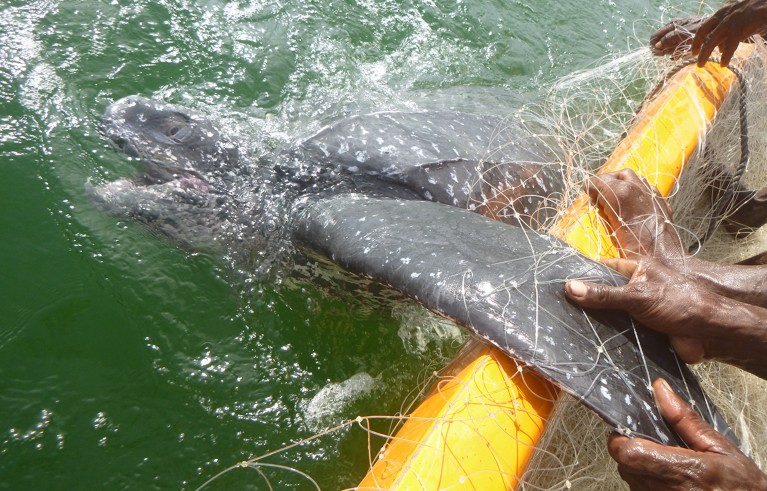
Turtles, marine mammals and non-target fish often get caught in nets used by people fishing for species that supply maw.Credit: Amos Ivei/Piku Biodiversity Network
Her work also exposed the previously unrecognized loss of another species coveted for its maw, the Chinese bahaba (Bahaba taipingensis)5, which can reach 2 metres in length and weigh more than 100 kilograms. Records from the 1930s found specimens in its habitat off the coast of China. Today it is so rare that “it is possible it will become the first marine commercial species to go extinct in recent times in the wild”, Sadovy says.
The cycles that have played out with the bahaba, totoaba and Nile perch “illustrate the consequences of escalating prices and lack of management”, including the implications for biodiversity, Sadovy and her colleagues warned in 20194. Concern over the trade has grown in the years since then. In 2021, in response to the high prices being paid for maw in Papua New Guinea, Bangladesh, India and French Guiana, the IUCN adopted a motion urging nations to control and monitor trade in the swim bladders of a group of ray-finned fishes known as big croakers to both protect the target species and reduce by-catch of threatened marine megafauna.
“A lot of people are beginning to realize — biologists, fisheries people — that maw is an issue,” says Sadovy. However, she adds that there are also a lot of places where the maw trade operates out of sight. Concerns about the trade are what motivated the drafting of the document submitted by the United States to CITES in July, she says. “It was a first initiative to highlight international maw trade as an issue threatening some species.”
Rewilding the planet: how seven artificial islands could help a dying Dutch lake
Sadovy hopes escalating concern will persuade international organizations — in particular, the Food and Agriculture Organization (FAO) of the UN — to become more active in documenting the trade. She wants to see the FAO follow Hong Kong’s lead and introduce a commodity code specifically for maw. “There are opportunities to actually seek better benefits for the fishermen themselves,” says Sadovy. “I see a win–win before some species are really pushed too far down.” But it needs to happen soon.
Without action at national and international levels, researchers warn that the risks for both vulnerable marine populations and the people who rely on them for income and food are dire. In the dozen years she has been working in the Kikori delta, Amepou has observed how precarious life is in the villages and how much the people there are exposed to the rapidly changing environment. She hears their stories and tries to answer questions about rising seas, changing weather and vanishing species.
Amepou likes to take the conversation back to the creature that drew her to the region: the turtle with the snout of a pig, remarkable enough to etch its way into local lore. When she first arrived, the people of the delta told her they had no concerns for its future, because the pig-nosed turtle was like their mother. It would always provide for them.
“And I say ‘your mother will provide for you to a certain point. There’s a time in life when you have to take care of your mother’,” Amepou says. “‘And it’s come to that point, where your mother kind of needs your help.’”



